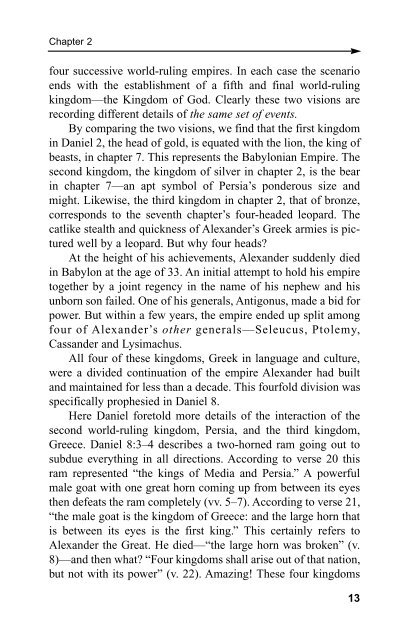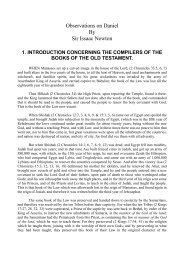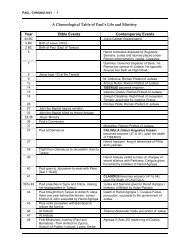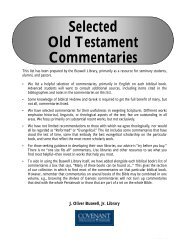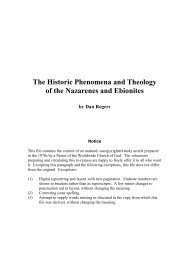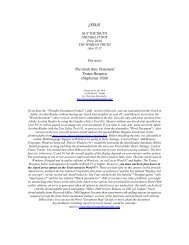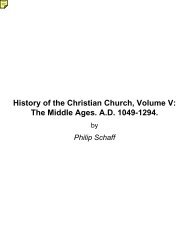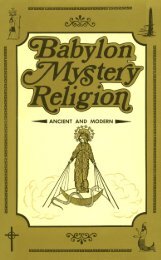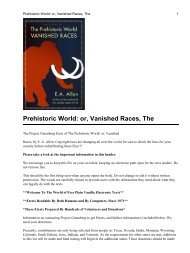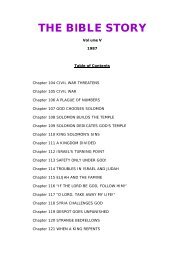Beast of Revelation.pdf - Friends of the Sabbath Australia
Beast of Revelation.pdf - Friends of the Sabbath Australia
Beast of Revelation.pdf - Friends of the Sabbath Australia
Create successful ePaper yourself
Turn your PDF publications into a flip-book with our unique Google optimized e-Paper software.
Chapter 2<br />
four successive world-ruling empires. In each case <strong>the</strong> scenario<br />
ends with <strong>the</strong> establishment <strong>of</strong> a fifth and final world-ruling<br />
kingdom—<strong>the</strong> Kingdom <strong>of</strong> God. Clearly <strong>the</strong>se two visions are<br />
recording different details <strong>of</strong> <strong>the</strong> same set <strong>of</strong> events.<br />
By comparing <strong>the</strong> two visions, we find that <strong>the</strong> first kingdom<br />
in Daniel 2, <strong>the</strong> head <strong>of</strong> gold, is equated with <strong>the</strong> lion, <strong>the</strong> king <strong>of</strong><br />
beasts, in chapter 7. This represents <strong>the</strong> Babylonian Empire. The<br />
second kingdom, <strong>the</strong> kingdom <strong>of</strong> silver in chapter 2, is <strong>the</strong> bear<br />
in chapter 7—an apt symbol <strong>of</strong> Persia’s ponderous size and<br />
might. Likewise, <strong>the</strong> third kingdom in chapter 2, that <strong>of</strong> bronze,<br />
corresponds to <strong>the</strong> seventh chapter’s four-headed leopard. The<br />
catlike stealth and quickness <strong>of</strong> Alexander’s Greek armies is pictured<br />
well by a leopard. But why four heads?<br />
At <strong>the</strong> height <strong>of</strong> his achievements, Alexander suddenly died<br />
in Babylon at <strong>the</strong> age <strong>of</strong> 33. An initial attempt to hold his empire<br />
toge<strong>the</strong>r by a joint regency in <strong>the</strong> name <strong>of</strong> his nephew and his<br />
unborn son failed. One <strong>of</strong> his generals, Antigonus, made a bid for<br />
power. But within a few years, <strong>the</strong> empire ended up split among<br />
four <strong>of</strong> Alexander’s o<strong>the</strong>r generals—Seleucus, Ptolemy,<br />
Cassander and Lysimachus.<br />
All four <strong>of</strong> <strong>the</strong>se kingdoms, Greek in language and culture,<br />
were a divided continuation <strong>of</strong> <strong>the</strong> empire Alexander had built<br />
and maintained for less than a decade. This fourfold division was<br />
specifically prophesied in Daniel 8.<br />
Here Daniel foretold more details <strong>of</strong> <strong>the</strong> interaction <strong>of</strong> <strong>the</strong><br />
second world-ruling kingdom, Persia, and <strong>the</strong> third kingdom,<br />
Greece. Daniel 8:3–4 describes a two-horned ram going out to<br />
subdue everything in all directions. According to verse 20 this<br />
ram represented “<strong>the</strong> kings <strong>of</strong> Media and Persia.” A powerful<br />
male goat with one great horn coming up from between its eyes<br />
<strong>the</strong>n defeats <strong>the</strong> ram completely (vv. 5–7). According to verse 21,<br />
“<strong>the</strong> male goat is <strong>the</strong> kingdom <strong>of</strong> Greece: and <strong>the</strong> large horn that<br />
is between its eyes is <strong>the</strong> first king.” This certainly refers to<br />
Alexander <strong>the</strong> Great. He died—“<strong>the</strong> large horn was broken” (v.<br />
8)—and <strong>the</strong>n what? “Four kingdoms shall arise out <strong>of</strong> that nation,<br />
but not with its power” (v. 22). Amazing! These four kingdoms<br />
13


